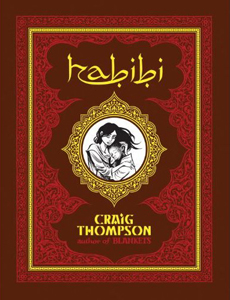Losing this reader’s trust

I read Habibi by Craig Thompson eagerly. It had received incredible buzz. The cover was stunning. Leafing through, I was enchanted by the gorgeous calligraphy. The setting was a fictional Middle East-a region I have mainly read about in the context of war, political upheaval, or dead civilizations. I was intrigued.
At first, the art and clever storytelling (of which the art is integral) swept me up. The narrative occurs on many levels. At its base is the love story of a girl and a boy who escape slavery only to be recaptured in cruel ways. Woven in are stories from the Qur’an, the Old and New Testament, and from the Thousand and One Nights; an exploration of numerology and Arabic calligraphy; an indictment of the ecological destruction wrought on water systems and on the desert; and a swipe at racism and the dismal status of women.
Something nagged at me, though.
I know precious little about Arabic culture, close to nothing about the Qur’an, and am equally uneducated about desert ecology. But I do know that all Arab men are not brutes. All Arab women are not sex objects. Parents love their children-in all cultures.
Granted, storytelling would be boring if protagonists only came from happy homes, had caring parents, and lived in a just world. Dystopia is a popular genre, after all. But Habibi promises something else: a view into another culture and another world.
And much of the book feels real. Although at first it isn’t clear when this tale takes place, we are clued in early that this is not the ancient past: there are car parts and a boat’s engine room. It's plausible to start the story with a child bride and slavery---unfortunately both still exist. As more of the narrative gets woven in, we encounter Mohammed in a respectful portrayal, and find Bible and Qur’an stories laid out with thought. The forays into the power of writing and numbers seem to be based on extensive research.
I am led to believe that there is truth here-the story may be fictitious, but the details are taken from life.
But they aren’t.
Women are repeatedly defined by their sexuality, with an almost pin-up fascination. Rape is portrayed as a turn-on. Characters are one stereotype after another (the Arab brute, the soulless soldier, the lustful black servant, the rapacious sultan, the fisherman-fool)---too much of the cast comes from central casting. Which makes me wonder, what does the author know about the culture he is depicting? How much of the set is false? And if the set isn't quite right, how can I trust his depiction of what is happening to the desert? Or trust that there aren’t errors in his researched sacred stories and calligraphy?
It’s not enough to get a culture’s art right. Culture is more than a people’s art. If you want me to trust that you are telling me something true, you have to get the people right, too.